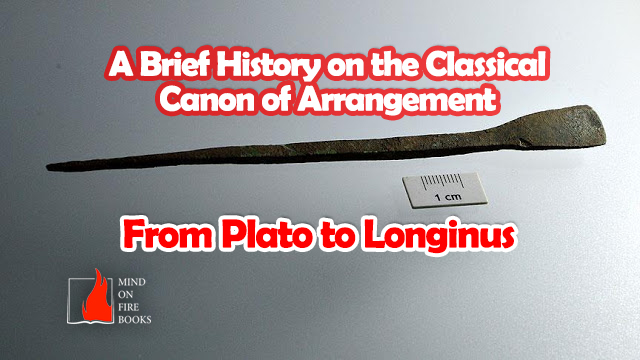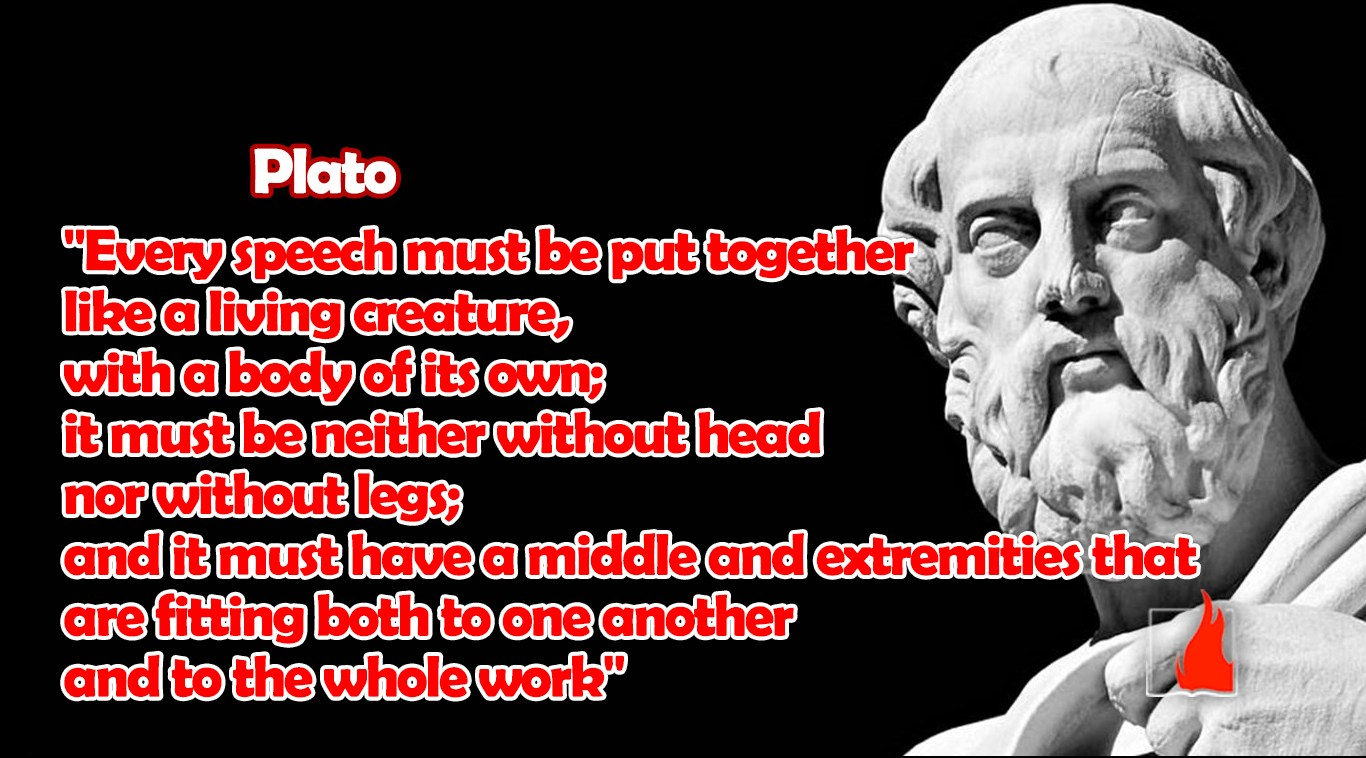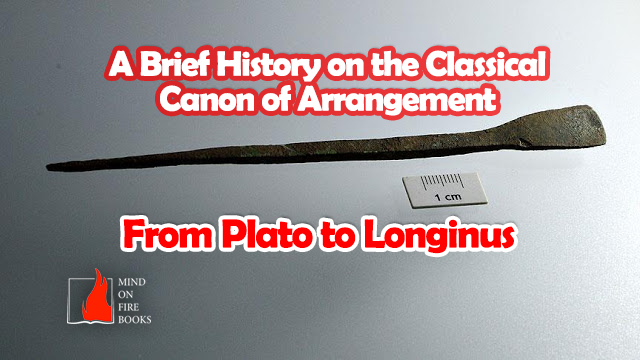“Every speech must be put together like a living creature, with a body of its own; it must be neither without head nor without legs; and it must have a middle and extremities that are fitting both to one another and to the whole work” – Plato in Phaedrus
Much has been said about this subject since its conception as an integral element to rhetoric by the Ancient Greek culture, at least in Western Traditions. Numerous treatise have been documented since then and there are many perspectives to look at when studying arrangement. This particular review will focus on a few rhetoricians of antiquity: Plato; Aristotle; Cicero and Longinus. Since the term “arrangement” is not a set definition, it becomes an idea or philosophy of how and where to apply its conditions. The canon of arrangement shifts in importance depending on the rhetorician, culture and even political background. But on the other hand, critics do agree on “at least this much: Every speech must be put together like a living creature, with a body of its own; it must be neither without head now without legs; and it must have a middle and extremities that are fitting both to one another and to the whole work” (Plato, Phaedrus.) So, lets take a step back into the days of the orator and begin with our Greek origins, at the heart of Athens.
From Plato’s text, Phaedrus the character of Socrates begins his inquiry into arrangement. Plato uses one of the prime literary pamphlets, One Eroticus by Lysias, distributed in Athens to begin the conversation and study on what rhetoric was thought to be. Plato was already been aware of the traditional four part structure being used in the Senate and knew exactly how important arrangement is (introduction, narrative, proof and conclusion.) Except Plato makes a jab at the four-part structure and draws an analogy that the characters Socrates and Phaedrus refer to its structure as having “distinguished four parts within the divine kind” (Phaedrus.) Calling these four parts something of a divine kind is a sarcastic remark on how all the major rhetoricians of the day follow that structure. Plato has already made it apparent at this point that arrangement is important, he is merely questioning the standard because he believes that rhetoric “takes many forms, like the shape of bodies, since, as we said, that’s what it Is to demonstrate the nature of something.” Even though these definitions are quite ornamental, nonetheless, Plato has begun to define arrangement.

A once claimed student of Plato, Aristotle eventually develops his own ideas on rhetoric which he expels in his lectures, published posthumously as On Rhetoric. In book 3 of this treatise, he applies his investigate methods to breaking down the different ways to talk and make a statement. The section addressed as arrangement was known as “taxis” to the Greeks which is translated by George Kennedy as having had a connotation to “the arrangement of troops for battle” because “the speaker needs to marshal the available means of persuasion for debate” (Aristotle.) He lets the reader know that since the orator acts as a guide through the facts, he has to be able to move the reader or listener to react with certain emotions (Aristotle.) Even though his method is aimed at objectively studying arrangement, Aristotle admits that any narration should be indicative of character, and that this character is reflected by how he manages the facts. Similar to Plato’s critique of the standard for arrangement, Aristotle agrees that “current [writers of rhetoric] make ridiculous divisions”, because they do not properly address the different contexts of the three different types of speeches; the deliberative, judicial and epideictic (Aristotle.) Aristotle then studies how to deliberate and narrate each type of speech (Aristotle). Different from the traditional four part structure is his foundation for a six part arrangement: Introduction, statement of facts, division, proof, refutation and conclusion. This new six part structure begins to develop what will become stasis theory, which is a way of looking at fact, or evidence in a case in order to build an argument. Stasis theory relies heavily on the arrangement of these facts and evidence.

Next up on the rostra is Cicero. In the introduction to Cicero’s On the Ideal Orator, the editor describes a time when the handbooks of the time were leaving the canon of arrangement emptier of content than should be. The handbooks were clumping the art of arrangement into the same process as invention. Cicero is said to have understood the importance of a more systematic approach, so he chooses to go back to Aristotle’s approach to arrangement rather than follow the trend at the time (31). The character Catalus asks his friend Antonius before his departure, “What do you think is the best order of the arguments” (Cicero.) Cicero expresses his ideas through guise of character and reinforces Aristotle’s presentation of the six part speech (intro, state facts, division, proof, refutation, conclusion) in order to find truth (Cicero.) In book 2, Cicero further investigates the importance of Arrangement. He claims that there are two main principals: “one is inherent in the nature of our cases” (208). It is important to have mastery over the arrangement of arguments because that is how the orator will stir up emotions in his audience. He then runs through the reasons of his arrangement model, but note that Cicero’s character only identifies three parts, he has condensed proof, refutation and the conclusion (Cicero.) Yet, still the same as Aristotle’s six parts, only condensed into three. In book 3, Cicero’s character expresses the importance of arrangement because even if the orator changes one word, they actually change the whole sentence and that an orator can say the same thing in different ways and still convene the same meaning. This same evidence can also be used to support his ideas of style which are closely related to arrangement.
The next rhetorician to say something about Arrangement is Quintilian in his Institutes of Oratory. I will not go into detail as to what he says since these readings were not assigned for the class, I would just like to point out where to find Quintilian’s ideas on arrangement for further references. He devotes book 4 to managing the parts of a forensic speech, book 5 to proofs/arrangement and then promotes stasis theory at book 7. Stasis theory is something that began with Aristotle and gets added to, transformed or upgraded to the different rhetoricians.
 The last of the rhetoricians to have said something about arrangement may come from Longinus. Except his thoughts on the subject are not prescriptive, in fact, Longinus sets out to identify the elements of lofty aesthetics in On the Sublime, so he deals mostly with style and arrangement is not spoke of in a technical manner. In section 10, Longinus says that there is “a law of nature that in all things there are certain constituent parts, coexistent with their substance” and that the rhetor must have “the power of afterwards combining them into one animate whole”. Longinus provides the reader with a passage written by Sappho because her “peculiar excellence lies in the felicity with which she chooses and unites together the most striking and powerful features” (Longinus.) Longinus’s mention of ‘arrangement’ as a canon is subtle and even implicit. This treatise does not spell out any tangible accounts of what arrangement should be.
The last of the rhetoricians to have said something about arrangement may come from Longinus. Except his thoughts on the subject are not prescriptive, in fact, Longinus sets out to identify the elements of lofty aesthetics in On the Sublime, so he deals mostly with style and arrangement is not spoke of in a technical manner. In section 10, Longinus says that there is “a law of nature that in all things there are certain constituent parts, coexistent with their substance” and that the rhetor must have “the power of afterwards combining them into one animate whole”. Longinus provides the reader with a passage written by Sappho because her “peculiar excellence lies in the felicity with which she chooses and unites together the most striking and powerful features” (Longinus.) Longinus’s mention of ‘arrangement’ as a canon is subtle and even implicit. This treatise does not spell out any tangible accounts of what arrangement should be.
“a law of nature that in all things there are certain constituent parts, coexistent with their substance” – Longinus
The classical rhetorical canon of arrangement and its studies by rhetoricians of antiquity still has merit. We still discuss the art of arrangement today, in our speech, our advertisements, and plans for the day and interacting in our daily lives. Even though we aren’t all Senate members or interested in legal language, the classical rhetoricians have identified parts of speech that affect all types of communication.







Leave a Reply